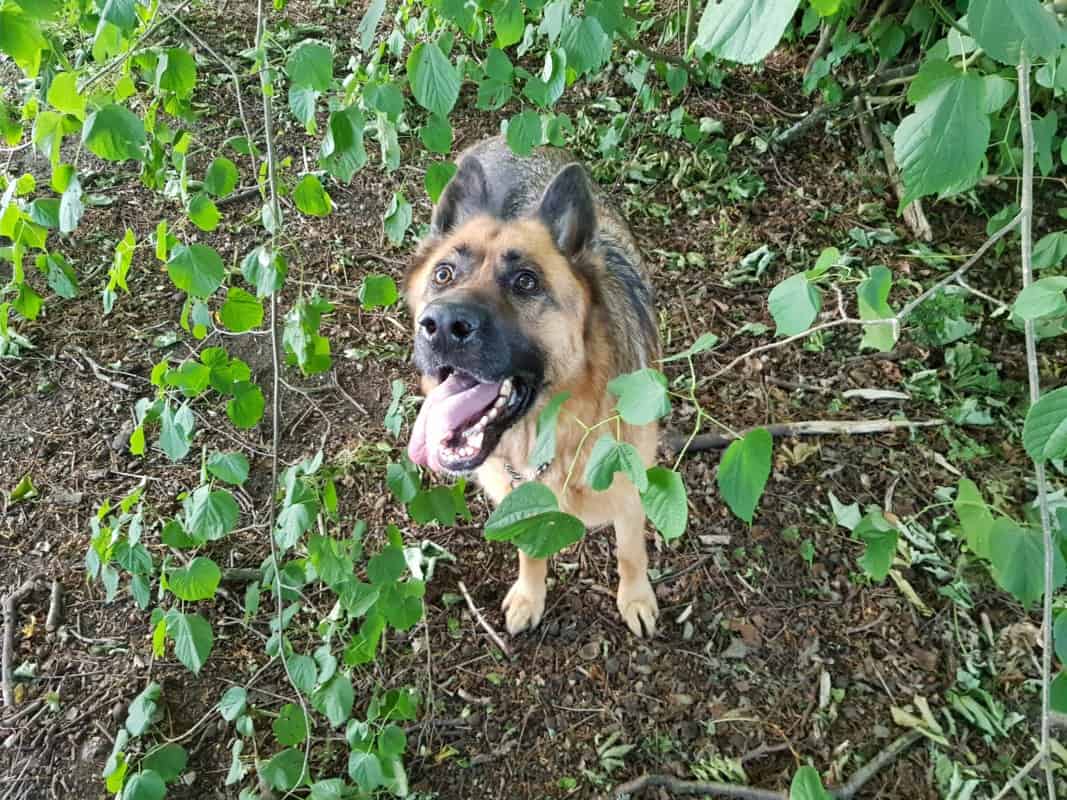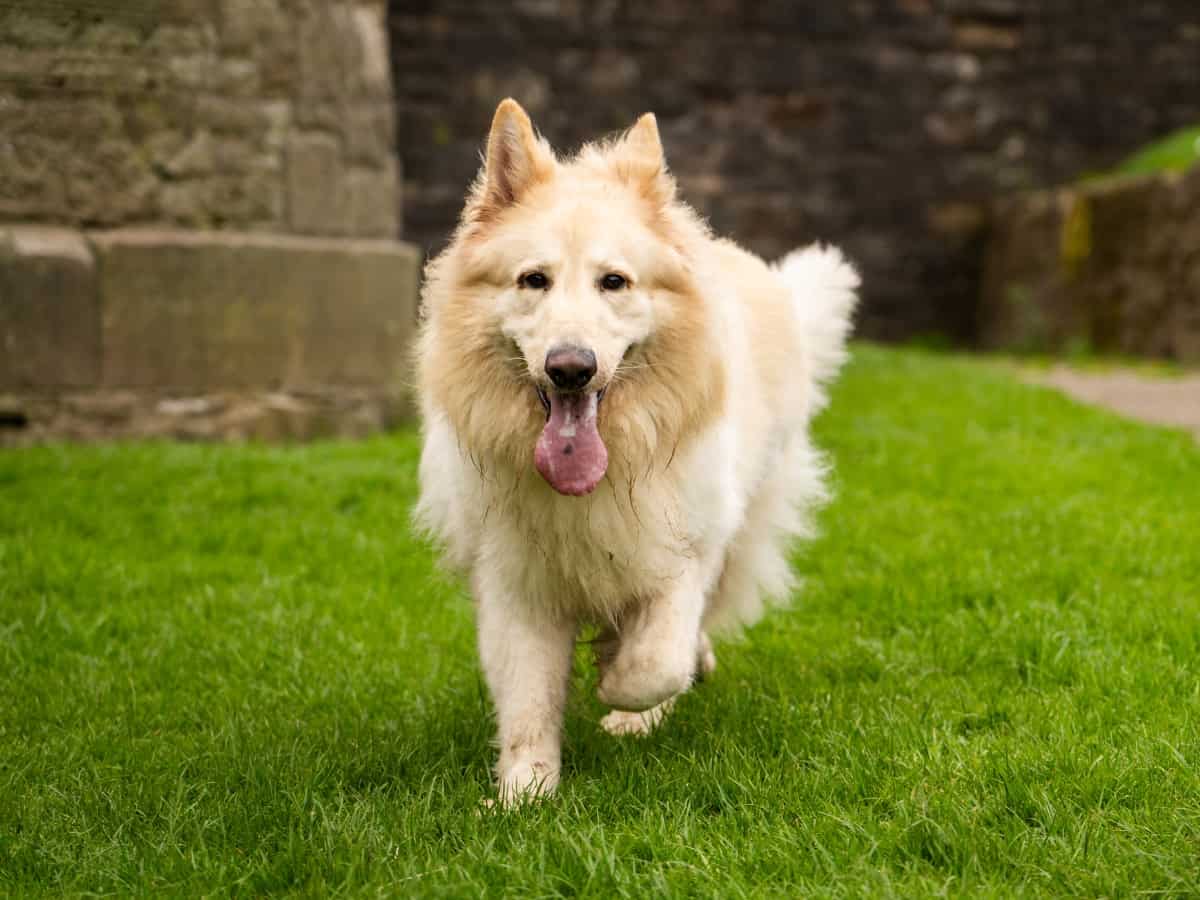How to tame German Shepherd prey drive becomes a fundamental question if you’ve witnessed your dog returning from its adventures with prey birds in its mouth or if it chases after small animals during walks.
This behavior is a display of its predatory instinct. Managing this drive involves understanding and addressing your German Shepherd’s natural tendencies.
To tame a German Shepherd’s prey drive, engage in regular, structured training focusing on obedience and impulse control. Use positive reinforcement, provide ample exercise, and introduce interactive play that satisfies their chase instinct, such as fetch or agility training.
Before I tell you more about taming your German Shepherd’s predatory instinct, you should know that prey drive is innate in dogs.
Check out the below photo of my German Shepherd after she’d chased a squirrel up a tree. You can see how alert and excited she is!
But what exactly is the German Shepherd prey drive?
Let’s tackle that first!

What Is Prey Drive in German Shepherds?
The German Shepherd’s prey drive is an instinctual behavior inherited from their ancestors, compelling them to chase and capture prey.
Originally bred for herding and guarding, this drive is a strong inclination to pursue moving objects, making training and socialization vital.
Dog biologists consider the predatory instinct in dogs to be genetic and characteristic of all dogs, thanks to their ancestral roots in the wolf.
However, the predatory urge manifests differently in every dog, and its intensity varies from breed to breed.
Among dog breeds with the strongest predatory instincts are those in the herding group, and the German Shepherd belongs to this group.
Exploring the Intensity of Prey Drive in German Shepherds
German Shepherds have a strong prey drive because they’re descendants of the grey wolf, hence their canine prey genes.
Also, they were bred to herd, and the original breeders knew it was essential to retain a bit of the predatory gene to make German Shepherds adept at their herding task.
A study focusing on the neurological genes for dog predation, among other behaviors, confirmed that prey drive in German Shepherds and other dogs is controlled by genes related to the dogs’ nervous system.
Like the German Shepherd, three of the neuronal genes control predation behavior among herding dogs.
In a natural environment, your German Shepherd’s prey drive would manifest in a series of behaviors:
- Search for the prey
- Stalking the prey
- Chasing or pursuing the prey
- Catching the prey
- Biting or killing the prey
However, domestication and selective breeding have reduced the strong predatory behavior in German Shepherds.
Despite this, the breed still stands out in predatory tendencies among its other counterparts.
For example, a Swedish behavior test study on German Shepherds and Labrador Retrievers found that the German Shepherds’ courage was highly correlated with the breed’s prey drive.
However, the two traits were poorly correlated in Labradors.
It implies that, even though the strong predatory behavior in German Shepherds has already been reduced, GSDs still need some training to keep their prey drive under control.
However, that doesn’t imply curtailing your dog’s natural hunting skills. And that’s where German Shepherd prey-drive training comes in!

German Shepherd Prey Drive Training
Some dog trainers will readily tell you that the best way to manage your German Shepherd if he has a strong prey drive is to keep him safely contained at home.
But such a solution trying to restrain may only cause more problems.
So, how do you convince your German Shepherd that squirrels, cats, and other small creatures aren’t necessarily meant to be its next meaty snack, and that cars and bicycles aren’t its speed challenge pacers?
Here’s how to tame your German Shepherd’s prey drive:
- Assess your German Shepherd prey drive.
- Redirect your German Shepherd prey drive.
- Don’t reward your German Shepherd’s prey behavior.
- Train your German Shepherd to reliable recall.
- Teach your German Shepherd impulse control.
- Keep your German Shepherd mentally stimulated.
- Make positive prey drive management choices.
1. Assess Your German Shepherd Prey Drive
If you want to tame your German Shepherd’s predatory instinct, you must first understand it.
Understanding your German Shepherd’s prey drive means observing the frequency and intensity of the behaviors manifesting the dog’s predatory instinct. Ask yourself these questions:
- Does your German Shepherd stare long and curious at potential prey, such as cats, chickens, squirrels, rabbits, and birds? These stares equate to searching for prey, which is the first stage of the prey drive.
- Does your dog have the habit of stalking and sniffing the path of target animals like cats and squirrels?
- Does your German Shepherd have the habit of fetching smaller animals, like birds and rodents, and bringing their kill to you?
- Does your doggo like running after anything that moves, including small animals, bikes, cars, skateboarders, and wildlife?
- Does your dog bite in a way that causes harm to you, other persons, dogs, or pets?
- Does your German Shepherd tend to kill its catch, even if it doesn’t eat it?
- Does your GSD tend to ignore your commands when staring at or pursuing prey?
- Is your best friend easily aroused by the slightest sound of a possible prey or runs when it hears such sounds?
If your answer to most of the questions was affirmative, then your German Shepherd will likely have a strong prey drive.

As you may have noticed from the photos of Willow, she has a strong prey drive. She loves to chase squirrels or foxes when out in the woods and will try to run after a passing motorbike.
Thankfully, she has never gone as far as fetching something back to me – maybe she is just not fast enough!
Next, I’ll discuss what practical steps to take to tame your dog’s strong predatory instinct.
2. Redirect Your German Shepherd’s Prey Drive
When your dog spots and begins to pursue prey, desist from shouting to your dog, as this could make a counter effect and cause him to persist in the chase.
Instead, find a positive way to distract your dog’s attention from the prey. It could be engaging your German Shepherd in his favorite “catch me” game or sending him to fetch a Frisbee instead.
Games such as tugging, chasing a ball, or ripping open stuffed toys are good ways to rechannel prey behavior and safely release the predatory instinct.
2. Don’t Reward Prey Behavior
Dog owners sometimes strengthen their dog’s prey drive by innocently encouraging their furry friends to pursue prey.
If your German Shepherd runs after another dog or pursues livestock or wildlife during a walk and you give it a treat when he returns, he’ll think that you love him pursuing prey and, thus, will keep repeating it.
Besides, allowing your dog to enjoy chasing livestock or wildlife could land you in legal trouble, as there are laws regulating this behavior.
For example, states like Pennsylvania, Idaho, Indiana, Maryland, and Montana have laws refraining dog owners from allowing their dogs to chase wildlife.

3. Train Reliable Recall
A reliable recall is a term used to describe the situation where a dog promptly responds to and returns to its owner’s call 99.99% of the time.
This training is essential in taming a German Shepherd’s prey drive and is a sure way to keep the dog safe. Besides, dogs characterized by reliable recall behavior can be given greater freedom off-leash and while out in public places.
Follow these simple steps to teach your German Shepherd reliable recall:
- Find a moment when your German Shepherd is distracted and away from you. Invite him to come to you by saying, “COME!”
- Reward your dog with a cue word like “YES!” or “GOOD DOG!” if he comes to you. Each time your dog responds, you can use a clicker and immediately follow the click with a treat or reward word. Doing so will teach your GSD to associate coming to you with a good experience.
- Repeat the same process at home until your dog learns to recall. Then, you can proceed to use it in different situations: when playing and your dog gets distracted when walking outdoors or in a public park.
Note that the primary goal is to have your German Shepherd associate come to you with a pleasant experience so that it will eventually prefer coming to you when you call instead of running after prey.
N.B. Teaching reliable recall takes time and patience. My German Shepherd was nearly two years old before I had her master perfect recall. However, this varies depending on the individual dog.
Factors influencing how long it takes to train a German Shepherd’s reliable recall include the training method, distraction level, bonding, and intensity of prey drive.
4. Teach Your German Shepherd Impulse Control
Because it’s essentially an instinct, your German Shepherd’s prey drive is, to a great extent, an impulse behavior that you need to educate.
Fortunately, dogs can learn impulse control quickly, especially when taught during puppyhood and before adolescence sets in.
Teaching your German Shepherd obedience commands related to its impulse behavior, such as “LEAVE IT,” and “COME,” is a primary part of impulse control training.
Consider these tips when teaching your German Shepherd impulse control commands:
- Work first in a quiet and controlled environment, like inside the house or the backyard.
- Gradually introduce distractions like an animated toy, a Frisbee, or a ball. A GSD with a strong prey drive will want to chase these toys, and you can use the obedience commands to teach him not to.
- Instruct your German Shepherd’s impulse control commands in an area with varied distractions until you know he shouldn’t yield to the urge to run after moving objects.

5. Keep Your Dog Mentally Stimulated
German Shepherd dogs require considerable mental stimulation to stay happy and healthy. They need a job or activity to keep them engaged.
If you don’t provide enough mental stimulation for a German Shepherd with a strong prey drive, it’ll find something to keep it engaged, and that could be running after cats and vehicles.
One way to keep your doggo mentally stimulated is to engage him in games that require him to use his sniffing skills in addition to the daily outdoor exercise.
For example, you can hide your dog’s favorite treats around the house or in the garden so that he can spend time trying to find them.
Other mentally stimulating activities you can consider for your German Shepherd include:
- Puzzle-solving: Try this highly interactive Nina Ottosson Puzzle Game from Amazon. I love this game as it engages your dog in finding his favorite treats by lifting bone shapes from several compartments.
- Dog training: Teach your dog to learn new tricks like shaking hands, playing dead, spinning, and rolling over.
- Memory test: Teach your dog the names of his toys, then test him to pick the right toy when you mention the name.
Note: Clicking the above link(s) will take you to Amazon or an online store where we have an affiliate relationship. If you make a purchase, we may earn a commission at no additional cost to you.
Varying your dog’s physical activities is also a good way of keeping him mentally stimulated.
Why not opt for a swim or hike once in a while? These activities can become substitutes or complementary exercises to daily walks.
6. Make Positive Prey Drive Management Choices
As much as you don’t want to restrain the natural aspect of your German Shepherd’s prey drive, it’s important not to create the occasions for an extreme expression of the predatory instinct.
As such, if your German Shepherd has a strong predatory instinct, you should consider these positive prey-drive management choices to tame him:
- Train your German Shepherd to recall and in other obedience commands like “LEAVE IT!” throughout his life. You should do this through positive reward-based training so your dog consistently learns that there are other rewarding experiences, not just chasing prey.
- Create a pet-friendly garden where your German Shepherd can run around and secure the garden. The fence should be high enough to prevent him from jumping over to chase smaller animals or vehicles, especially if your GSD has not fully learned recall.
- Keep your German Shepherd on a leash and harness during your daily walkies. Unless you’re certain your dog will listen if you ask not to chase moving objects or animals, always keep your dog close to you. I use the Walk Your Dog With Love No-Pull Harness as it leads from the front, allowing greater control and steerability.
- Muzzle train your German Shepherd and use the muzzle when in public. Doing this is especially important if your dog’s prey drive tends to reach the final biting stage. Also, help your dog associate wearing a muzzle with a positive experience, like going shopping with you instead of staying home alone.

FAQs
Why Do German Shepherds Chase (Cars, Squirrels, Bicycles, Cats, etc.)?
German Shepherds chase cars, squirrels, bicycles, cats, skateboarders, wildlife, and more because chasing moving objects and animals is instinctive due to a canine’s natural prey drive.
Since German Shepherds are descendants of the grey wolf and have inherited a dose of their ancestors’ strong predatory instinct, as well as looks, it’s not surprising that some of their behaviors are similar to those of wolves.
Furthermore, German Shepherds were bred to herd, and herding dogs have a strong prey drive.
Are German Shepherds Hunters?
Although not generally used as hunting dogs, German Shepherds can be trained to hunt animals such as deer due to their strong prey drive and excellent tracking abilities. However, as original herding dogs, they are more suited to law enforcement work, guarding, and search and rescue work.
Are German Shepherds Good at Tracking?
German Shepherds are good at tracking. They have an outstanding ability to track and detect humans, drugs, bombs, deer, etc., due to their extraordinary sense of smell. Their additional traits of stamina, high trainability, confidence, high energy, bravery, make them the perfect tracking dog.
Read More: How to Train a German Shepherd to Find Things
Key Takeaways
German Shepherd prey drive is the breed’s innate instinct that makes them want to pursue and capture prey and chase moving objects.
Since they inherited the instinct from their wolf ancestors and how they were bred, they have a strong prey drive.
If your German Shepherd has a strong prey drive and you want to keep it under control, you can tame it through training.
You can do this by distracting your dog’s focus on the prey, teaching him reliable recall and impulse control, ensuring he’s mentally stimulated, and not rewarding his prey behavior.





